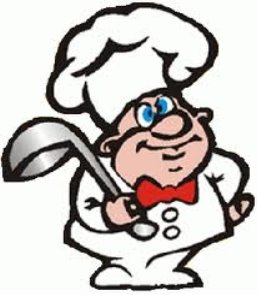Щоденне меню. У ресторані (The Daily Menu. At the Restaurant)
Тема: Харчування
UNIT 4. NATIONAL CUISINE
Урок 5
Підтема: Щоденне меню. У ресторані (The Daily Menu. At the Restaurant).
Мета:
практична: повторити лексику теми; формувати навички аудіювання; удосконалювати техніку читання; розвивати навички діалогічного мовлення;
освітня: поглибити знання учнів про традицій харчування англійців у закладах громадського харчування; тренувати у письмі.
розвивача: розвивати ерудицію учнів; розвивати мовну здогадку та мовленнєву реакцію учнів; розвивати здатність до мовного самоконтролю; розвивати уяву учнів в умовах драматизації діалогів та роботи в парах.
виховна: виховувати інтерес до традицій харчування англійців у закладах громадського харчування; виховувати інтерес до вивчення англійської мови.
Обладнання: підручник з англійської мови для 10 класу, робочий зошит, роздатковий матеріал.
Тип уроку: комбінований.
Тема: Харчування
UNIT 4. NATIONAL CUISINE
Урок 5
Підтема: Щоденне меню. У ресторані (The Daily Menu. At the Restaurant).
Мета:
практична: повторити лексику теми; формувати навички аудіювання; удосконалювати техніку читання; розвивати навички діалогічного мовлення;
освітня: поглибити знання учнів про традицій харчування англійців у закладах громадського харчування; тренувати у письмі.
розвивача: розвивати ерудицію учнів; розвивати мовну здогадку та мовленнєву реакцію учнів; розвивати здатність до мовного самоконтролю; розвивати уяву учнів в умовах драматизації діалогів та роботи в парах.
виховна: виховувати інтерес до традицій харчування англійців у закладах громадського харчування; виховувати інтерес до вивчення англійської мови.
Обладнання: підручник з англійської мови для 10 класу, робочий зошит, роздатковий матеріал.
Тип уроку: комбінований.
Хід уроку
І. ОРГАНІЗАЦІЙНИЙ МОМЕНТ
Introduction 1. Організація класу.
Greeting 2. Привітання.
T: Good morning, children, I’m glad to see you. How are you getting on?
Ps: We are glad to see you too!
Aim 3. Повідомлення теми та мети уроку.
T: There’s no doubt that food is very important in our life. People and all living can’t live without eating. Each country has its own eating traditions. So, we are going to speak about food, eating habits and eating out in restaurants, cafes, our favourite dishes, likes and dislikes.
Warming up 3. Уведення в іншомовну атмосферу.
1) T: First, please answer my questions:
1. Do you like cooking?
2. What is cooking for you: an art or a dull every day duty?
3. Who usually cooks in your family?
4. What national Ukrainian dishes do you know?
5. What is your favourite food?
6. Would you like to open any exotic restaurant in your town?
7. Would you like to be a chef?
8. What are the popular dishes in your family?
9. How often do you eat out? What’s your favourite café?
2) T: Let’s revise words connected with food. Listen to me and try to find the odd word out.
1. water, coke, bread, wine, juice;
2. boil, bake, fry, bowl, grill;
3. salty, pepper, spicy, sweet, bitter;
4. slice, cut, chop, stew, peel;
5. dish, meal, bowl, plate, cup;
6. potato, carrot, plum, cabbage, beet.
II. ОCНОВНА ЧАСТИНА УРОКУ
Vocabulary Revision 1. Активізація використання лексичного матеріалу.
T: Let’s make an association map. Go to the blackboard and write what menu can be.
![]() Menu for breakfast Menu for lunch Cocktail party menu
Menu for breakfast Menu for lunch Cocktail party menu
![]()
![]()
![]()
![]() Menu for dinner A COOK’S MENU Home-made menu
Menu for dinner A COOK’S MENU Home-made menu
Daily menu Formal dinner menu
Work in groups
T: Let’s speak about a daily menu and analyze it. By the way, what daily menu is considered to be healthy?
As far as I know, a healthy menu has to include the dishes which provide us with vitamins and carbohydrates, and it doesn’t have to be fright in calories and saturated fat and lacking in nutrition.
Now divide into groups of four and make the daily menu adding the dishes recipes of which you have prepared at home.
Use the table
Dishes/Food
Menu
Starter: _________________________________.
Main course : ____________________________.
Dessert: ________________________________.
Drinks: _________________________________.
Check on Homework 2. Перевірка домашнього завдання.
T: Well let’s check up your homework.
 Nowadays eating out is very popular in all countries and large cities. Sometimes people spend much money on it. Our town also has a wide range of restaurants and cafes offering cuisines from different countries. And your homework for today was to prepare some information about famous restaurants in London. Let’s listen to some pupils. (Reports about restaurants in London). We have just learnt about some restaurants.
Nowadays eating out is very popular in all countries and large cities. Sometimes people spend much money on it. Our town also has a wide range of restaurants and cafes offering cuisines from different countries. And your homework for today was to prepare some information about famous restaurants in London. Let’s listen to some pupils. (Reports about restaurants in London). We have just learnt about some restaurants.
What are their names?
- What food are served in each of them?
- Would you like to visit restaurants with the traditional food of other countries?
- Food from what country would you like to try?
Speaking 3. Розвиток діалогічного мовлення
T: We like going to cafés with our family or friends. And you were given tasks to make up dialogues about eating out. Who is ready?
Possible dialogues:
Dialogue 1
ORDERING FOOD/DRINKS BY PHONE
ANN: Hello! "Pronto".
BOB: Hello, I would like to order something, please.
A: Sure, what would you like?
B: Two pizzas: special and deluxe.
A: Sorry. Pizza deluxe is not available.
B: What a pity! It’s my favourite one.
A: Let me recommend you Milano. It’s a special treat.
B: Okay. Then special pizza and Milano.
A: Would you like anything to drink?
B: Yes. I'll have two bottles of mineral water.
A: Okay. What’s your address, please?
B: It's 32 Glinka Street.
A: And your phone number?
B: 56185.
A: It'll be delivered in about 20 minutes.
B:That’s great. Thanks a lot. Bye.
A: Thank you.
Dialogue 2
ANN: Let’s drop in here. This restaurant is famous for its service.
BOB: Waiter! Is this table vacant?
WAITER: You’re welcome, sir.
A: Shall we have any appetizers for beginning?
B: I think we will. I’d like to have fish in jelly. It’ delicious.
A: As for me, I’d like some salad and caviar.
B: And what shall we have for a drink?
A: Orange juice and mineral water.
B: Shall we begin with starters?
A: I don’t want to.
B: Tell us, please, what meat courses are there on menu?
W: There is beefsteak with mushrooms and rissoles.
A: Are there any fish courses on menu?
W: Of course! Stuffed fish, salmon, fish pate. Besides, there's roast chicken and chops.
B: What side-dish shall we order? I think, cauliflower and green peas.
A: Waiter, bring us one stuffed fish, two salmons, two beefsteaks with mushrooms and one veal chop. Two coffees.
W: Would you like ice-cream to coffee?
B: Yes, please.
Dialogue 3
Waiter: Good evening sir, madame.
Mr Smith: Good evening. We have a reservation for a table for two in the name of Smith.
Waiter: You’re welcome. Would you like to come to the table or would you prefer to order in the bar?
Mr Smith: We’ll order in the bar.
Waiter: Are you ready to order sir?
Mr Smith: Not really. Could you recommend something.
Waiter: Certainly sir. The fresh lobster is particularly good this evening?
Mr Smith: Sounds lovely, what do you think dear?
Mrs Smith: Oh yes, I love lobster.
Waiter: So, that’s two consomme and two lobsters. Would you like to look at the wine menu?
Mr Smith: Why don't you bring us what you think will go best. Nothing too expensive though.
Waiter: No problem sir. I'll call you as soon as your table is ready.
Waiter: Was everything to your satisfaction?
Mr & Mrs Smith: Yes, lovely thank you.
Mr Smith: The whole meal was delicious, our compliments to the chef. Сould we pay now?
Waiter: Certainly sir, I’ll bring you the bill. Would you like me to order you a taxi.
Mr Smith: Yes that would be great, thank you.
Listening Comprehension 4. Удосконалення навичок аудіювання.
T: Now , let’s listen to the dialogue between the interviewer and George.
Впр. 4 (с. 71)
Be attentive and then we will do the task ( true or false). If the sentence is false, please, explain why.
Interviewer: George, why did you decide to open a restaurant in Argentina?
George: I’d always wanted to have my own restaurant and it would have been very expensive to do that in England.
Interviewer: What kind of food do you serve?
George: Mainly international dishes like pasta. Steak and fries, risotto – but we also do several English dishes as well.
Interviewer: Were Argentinian people surprised when they heard that an English chef was going to open a restaurant here?
George: Yes, they were – very! I think people do not usually expect the English to be good cooks.
Interviewer: Is your chef English?
George: No, he is Argentinian – but I have taught him to make some English dishes.
Interviewer: What kind of English dishes do you have on your menu?
George: Well, we are open in the morning, and we serve traditional English breakfast, and then we have a lot of English desserts at lunchtime, for example, trifle – that is typical English dessert made with fruit and cake and cream. And we do proper English teas in the afternoon – tea with cakes and sandwiches.
Interviewer: Are the English dishes popular?
George: Yes, especially the desserts and cakes. I think people here in Argentina have a very sweet tooth.
Interviewer: And finally is there any English food that you really miss here?
George: The thing I miss most living in Argentina is English cheese. I really miss Stilton – which is a wonderful English blue cheese. It is not as famous as some of the French cheese like Roquefort but I think it should be. You should try it.
Interviewer: I will try! Thank you for the interview.
George: Welcome to the restaurant!
T: Now read the statements below and put “T” for the TRUE sentences and “F” for the FALSE ones.

ІІІ. ЗАКЛЮЧНА ЧАСТИНА УРОКУ
Homework 1. Домашнє завдання.
Your hometask for the next lesson is to prepare short reports about famous national cuisines.
Summarizing 2. Підведення підсумків уроку.
Бесіда в режимі T→P 1 →P 2 →P 3.
T: What was the service like? Would you recommend your friend to visit this restaurant? You have been working hard today. The lesson is over. You are free. Your marks are ….
Cl. Thank you teacher. Goodbye!


про публікацію авторської розробки
Додати розробку
